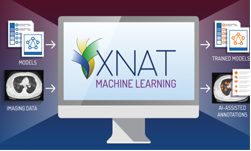Driving the future of healthcare imaging, NVIDIA MONAI microservices are creating unique state-of-the-art models and expanded modalities to meet the demands of the healthcare and biopharma industry. The latest update introduces a suite of new features designed to further enhance the capabilities and efficiency of medical imaging workflows. This post explores the following new features:
- Batch inference
- Custom training with MONAI Bundles
- A novel generative AI model for CT images
- Significant upgrades to VISTA models
Batch inference and custom training
Real-time inference in the NVIDIA MONAI platform has been instrumental in streamlining the interactive annotation workflow. Now, with the introduction of batch inference, users can process large volumes of medical images simultaneously. Enabling faster, more efficient analysis without compromising accuracy, this capability is crucial for institutions and researchers working with extensive datasets.
In addition, custom training with MONAI Bundles enables users to tailor AI models to their unique needs. Custom training leverages the MONAI Bundle Specification to enhance the platform’s ability to address your unique imaging needs with greater flexibility. Start with any MONAI Bundle from the NVIDIA NGC catalog and customize it for your workflow.
Generative AI for synthetic CT image generation
A new generative AI model, MAISI (Medical AI for Synthetic Imaging), is now available in NVIDIA MONAI, capable of producing high-resolution CT images (512 × 512 × 512) with up to 132 anatomical classes. This model enhances data augmentation by generating diverse, realistic datasets where actual images are limited. It streamlines the annotation process by generating detailed (image, label) pairs automatically. The model offers an ethical alternative for using sensitive patient data. Later this year, NVIDIA will unveil a fine-tuning workflow for customization, enabling users to refine this model for specific tasks.
VISTA-3D and VISTA-2D for advanced imaging
The VISTA-3D (Versatile Imaging SegmenTation and Annotation) model is a cornerstone of the platform, known for its accuracy, generalizability, and interactivity. I’m excited to announce an update to VISTA-3D, which now includes 130 classes. It has been trained on both labeled and unlabeled data. The model’s performance has been increased through continued training and extensive evaluations on additional datasets.
Enhanced through the strategic use of pseudo labels, this update not only refines the model’s accuracy but also shifts the dice score distribution upwards, reducing instances of lower performance. This enhancement significantly improves its few-shot and zero-shot learning capabilities, making it even more powerful for diverse medical imaging tasks. It’s also more powerful for adapting to unique tasks with continual learning.
In addition, this update introduces the VISTA-2D model, specifically designed for cellular imaging. Available for inference and training, VISTA-2D enables users to develop custom models fine-tuned to their specific datasets. While it may not include pretrained weights, internal benchmarks have shown that models trained with VISTA-2D can surpass the performance of leading state-of-the-art models like CellPose, even with limited training data. This performance underscores the strength of VISTA-2D as the starting point for a tailored imaging solution for cellular imaging.
NVIDIA NIM for medical imaging
The new suite of healthcare microservices includes NVIDIA NIM, a set of microservices providing optimized inference for a broad collection of models. VISTA-3D is available now. A NIM is an easy-to-use, self-hosted microservice designed to streamline the development of AI-powered enterprise applications and the deployment of AI models in production.
Summary
NVIDIA MONAI microservices continue to evolve, driven by NVIDIA’s commitment to advancing medical imaging through AI. The introduction of batch inference, custom training, and synthetic data generation, along with updates to VISTA-3D and the new VISTA-2D, help to address the needs of the medical imaging community. These advancements continue to support state-of-the-art solutions that empower researchers, annotators, and developers to achieve more with their medical imaging projects and streamline the adoption of advanced AI technologies across medical and biopharma domains.
To experience the full capabilities of NVIDIA MONAI microservices and explore these new features, sign up for the early access program.










